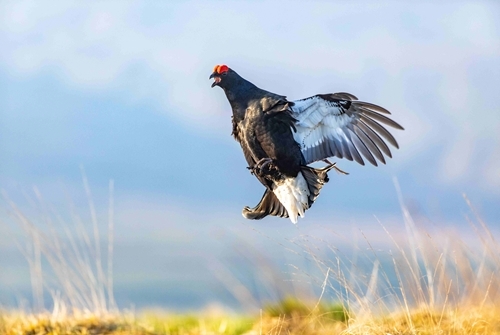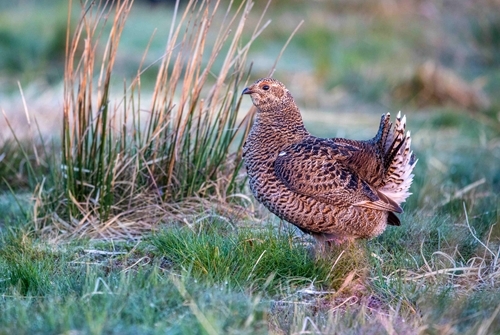
Photo Credit: Emily Graham Media
A new project by the Game & Wildlife Conservation Trust (GWCT) is underway to translocate black grouse from their stronghold in the North Pennines to the North York Moors to expand their range and help them to recolonise areas where they have not bred for nearly 200 years.
Black grouse are red listed as a species of high conservation concern. In England, they are now largely restricted to the North Pennines, which includes parts of County Durham, Northumberland, Cumbria and North Yorkshire. Here, numbers remain broadly stable, fluctuating between 1-2,000 displaying males over the last 25 years.
The North York Moors have been selected following landscape-scale habitat improvements on the fringes of moorland managed for grouse shooting. This has included the removal of conifer woodland and restoration to bog, heath and scrub woodland, moorland grasslands being managed more extensively and bracken control restoring bilberry and heather moorland. There have been sporadic sightings of black grouse in the North York Moors, but there is no record of them breeding here since the 1840s.
Led by researchers from the trust’s Uplands team and funded by £164,000 from Natural England’s Species Recovery Programme Capital Grant Scheme, the Black Grouse Range Expansion Project will also look to explore brood rearing and foraging habitats currently used by black grouse hens in the North Pennines.

Photo Credit: Emily Graham Media
Translocation of birds
Birds will be caught at night and immediately transported to and released into a specially selected site, which has the required mix of habitats for them. This will be done under a licence from Natural England.
Some of the birds will be equipped with radio transmitters to allow researchers to follow settlement patterns, survival and lekking behaviour.
Dr Phil Warren, from GWCT and leading the project, says: “Natural re-colonisation of black grouse to the North York Moors from the existing populations in the North Pennines is currently limited by the 30-km gap across unsuitable lowland farmland habitats in the Vale of Mowbray, which is on the limit of the dispersal range of black grouse.
“In recent years, occasional females have been seen, but no breeding recorded. We wish to help them re-establish here by moving birds to take advantage of habitat improvements and a likely more favourable climate, which is typically drier and warmer in June when chicks hatch.”

Photo Credit: Emily Graham Media
Brood-foraging habitat
The work to study the brood foraging habitat began in the spring and involved fitting seven hens with GPS tags under BTO licence, then remotely tracking them to determine their daily foraging ranges and their evening roosting locations without disturbing them.
The work to tag and track more hens will continue next spring, providing ongoing funding can be secured. The GWCT will be running a Black Grouse Appeal to raise money towards the project in the lead up to Christmas.
As part of the brood foraging study, the team are also studying how livestock grazing influences the composition and abundance of invertebrates, especially sawfly larvae, which black grouse chicks like to feed on.
Phil says: “A greater understanding of how to maximise invertebrate abundance would, if implemented, help off-set negative impacts of June rain to chicks and improve the current low levels of chick survival.”
It is hoped the findings of the of project will help guide landscape-scale management of moorland fringe grasslands to benefit black grouse and to increase its range to help mitigate against likely future impacts of climate change.

Photo Credit: Emily Graham Media
About black grouse (Lyrurus tetrix)
A grouse of moorland and forest edge, the black grouse is best known for its early morning spring-time gatherings, called ‘leks’, where the males gather to compete for females. They display by fanning out their elaborate, lyre-shaped tails and inflating their necks to signal their vigour and defend or claim their territory. Their song consists of a long, dove-like bubbling coo or murmur, The hens arrive at the lek to pick the overall healthiest male, which they will mate with.
Males are jet black with long, curved tail feathers. They have a slim white stripe in the wing and white feathers under the tail. Females are well camouflaged with finely barred brown and black plumage and have a cackling call. The female takes all responsibility for nesting and rearing the chicks.
Black grouse favour a mosaic of moorland habitats and marginal farmland that are near to woodland, and the species initially benefited from the planting of commercial forestry plantations following the Second World War. However, as these plantations matured, they have become unsuitable for the species. Changes in land management have taken a toll on the population in modern times.
- Ends -
Notes for editors:
The Game & Wildlife Conservation Trust Providing research-led conservation for a thriving countryside. The GWCT is an independent wildlife conservation charity which has carried out scientific research into Britain’s game and wildlife since the 1930s. We advise farmers and landowners on improving wildlife habitats. We employ more than 60 post-doctoral scientists and other research staff with expertise in areas such as birds, insects, mammals, farming, fish and statistics. We undertake our own research as well as projects funded by contract and grant-aid from Government and private bodies.
Natural England
· The Species Recovery Programme (SRP), which Natural England has been operating for more than thirty years, has helped to drive targeted action to reverse the fortunes of many of England’s most threatened species.
· The Programme has been enhanced through the new Species Recovery Programme Capital Grants Scheme (SRPCGS) launched in April 2023. An announcement of 63 successful projects was made by Natural England on 14 September 2023. Led by 46 organisations with a further 28 partners the total value of these SRPCGS grant awards is £14.5 million. 150 threatened species are being targeted to benefit from this investment over two financial years.
· The Species Recovery Programme is focused on reducing the risk of extinction and promoting the recovery of our most threatened species, especially through bespoke targeted action for these species. Through the SRP, Natural England works together with, and facilitates involvement from, a wide range of partner organisations to tackle the recovery of England’s threatened wildlife, working collaboratively to drive nature’s recovery.
For more information, images or to arrange an interview please contact:
Eleanor Williams, GWCT Press Officer
- ewilliams@gwct.org.uk
- 07592 025476